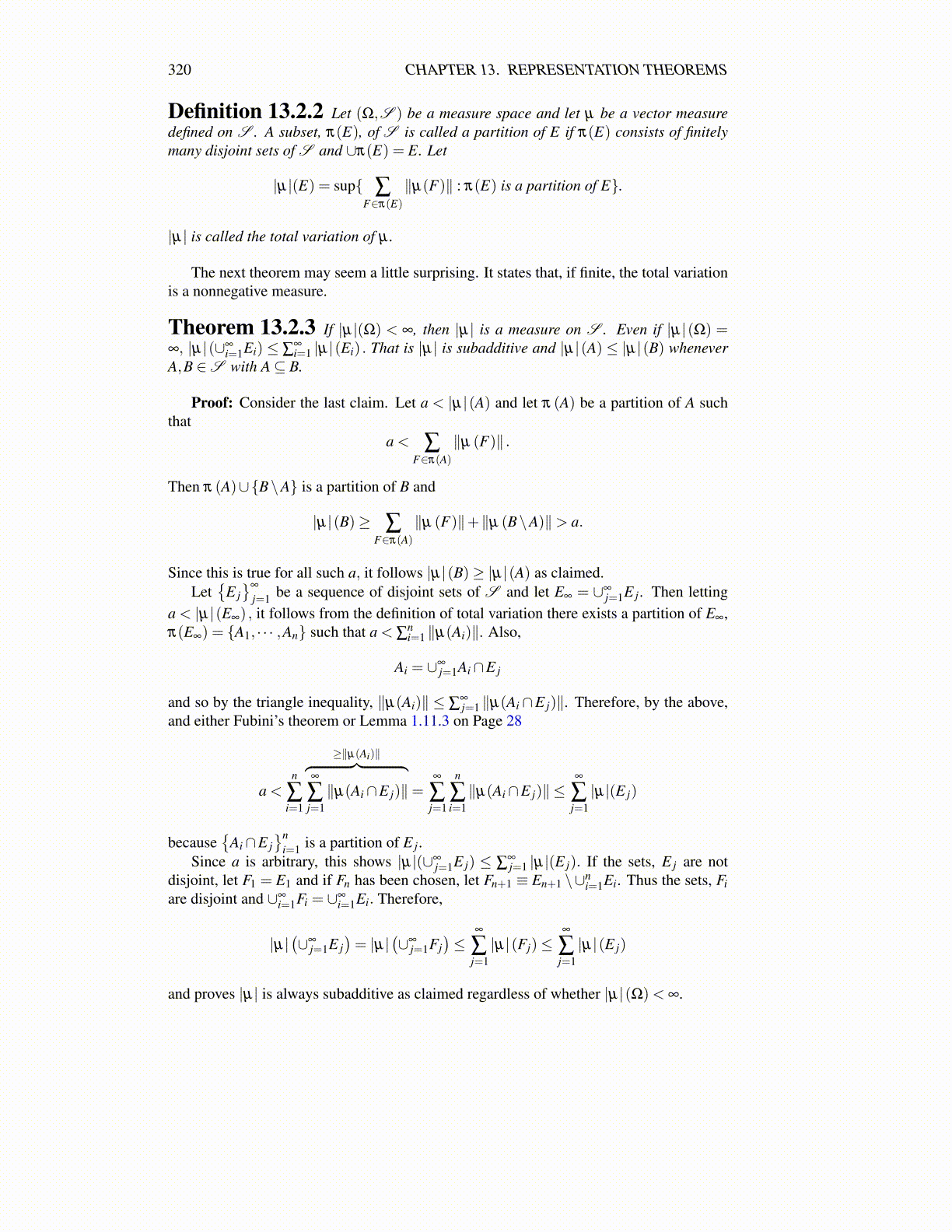
320 CHAPTER 13. REPRESENTATION THEOREMS
Definition 13.2.2 Let (Ω,S ) be a measure space and let µ be a vector measuredefined on S . A subset, π(E), of S is called a partition of E if π(E) consists of finitelymany disjoint sets of S and ∪π(E) = E. Let
|µ|(E) = sup{ ∑F∈π(E)
∥µ(F)∥ : π(E) is a partition of E}.
|µ| is called the total variation of µ .
The next theorem may seem a little surprising. It states that, if finite, the total variationis a nonnegative measure.
Theorem 13.2.3 If |µ|(Ω) < ∞, then |µ| is a measure on S . Even if |µ|(Ω) =∞, |µ|(∪∞
i=1Ei) ≤ ∑∞i=1 |µ|(Ei) . That is |µ| is subadditive and |µ|(A) ≤ |µ|(B) whenever
A,B ∈S with A⊆ B.
Proof: Consider the last claim. Let a < |µ|(A) and let π (A) be a partition of A suchthat
a < ∑F∈π(A)
∥µ (F)∥ .
Then π (A)∪{B\A} is a partition of B and
|µ|(B)≥ ∑F∈π(A)
∥µ (F)∥+∥µ (B\A)∥> a.
Since this is true for all such a, it follows |µ|(B)≥ |µ|(A) as claimed.Let
{E j}∞
j=1 be a sequence of disjoint sets of S and let E∞ = ∪∞j=1E j. Then letting
a < |µ|(E∞) , it follows from the definition of total variation there exists a partition of E∞,π(E∞) = {A1, · · · ,An} such that a < ∑
ni=1 ∥µ(Ai)∥. Also,
Ai = ∪∞j=1Ai∩E j
and so by the triangle inequality, ∥µ(Ai)∥ ≤ ∑∞j=1 ∥µ(Ai ∩E j)∥. Therefore, by the above,
and either Fubini’s theorem or Lemma 1.11.3 on Page 28
a <n
∑i=1
≥∥µ(Ai)∥︷ ︸︸ ︷∞
∑j=1∥µ(Ai∩E j)∥=
∞
∑j=1
n
∑i=1∥µ(Ai∩E j)∥ ≤
∞
∑j=1|µ|(E j)
because{
Ai∩E j}n
i=1 is a partition of E j.Since a is arbitrary, this shows |µ|(∪∞
j=1E j) ≤ ∑∞j=1 |µ|(E j). If the sets, E j are not
disjoint, let F1 = E1 and if Fn has been chosen, let Fn+1 ≡ En+1 \∪ni=1Ei. Thus the sets, Fi
are disjoint and ∪∞i=1Fi = ∪∞
i=1Ei. Therefore,
|µ|(∪∞
j=1E j)= |µ|
(∪∞
j=1Fj)≤
∞
∑j=1|µ|(Fj)≤
∞
∑j=1|µ|(E j)
and proves |µ| is always subadditive as claimed regardless of whether |µ|(Ω)< ∞.